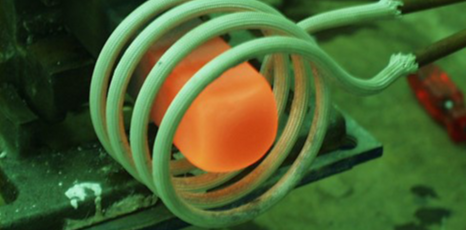Induction Brazing an Aluminum Assembly
Objective A company wanted to assess using induction heating for their aluminum assembly brazing process, and contacted THE LAB at Ambrell to utilize...
Applications
Applications: More
Applications: More

Industries:
Industries: More
Industries: More
Industries: More

Products:
Products: More
Services:
Services: More

Learn:
Learn: More
About:


A company contacted THE LAB at Ambrell to anneal the ends of metal stamp sets of various sizes with induction heating. They had been using a torch but wanted a safer and more repeatable heating method. The client needed to heat S7 steel of varying rectangular cross-sectional sizes to 1,400-1,800 ºF (760-982 ºC).
More induction annealing application notes
THE LAB determined that an EASYHEATTM 7.5 kW, 150-400 kHz induction heating system with four-turn or five-turn helical induction heating coils (depending on part size) would be the right solution for the client and their requirements.
One five-turn and two four-turn helical coils were used to heat the end of the stamps to the target temperature. Two stamp sizes can be run in each of the coils using the same system settings except for cycle time. Cycle rates were dependent upon the cross-section size. The 3/8” (0.9525 cm) square size had a rate of under 10 seconds. The rate for the middle size, which was ½” – 1 ½ “ (1.27 - 3.81 cm), was 30 to 60 seconds. A 1” (2.54 cm) square part took approximately two minutes to heat to temperature. Fixturing can also influence cycle time. If a faster heating time is ever required, a higher power system would achieve that objective.
The client moved from a torch to induction heating for several reasons. First, the rapid heating offered by induction boosted throughput. Induction is also more precise and efficient, as it only heated the end of the stamp which was the only portion of the part that required heating. It is also a highly repeatable heating method, so while torch heating is highly dependent on operator skill, induction lends itself to superior repeatability. Finally, with no open flame, induction offers considerable benefits when it comes to workplace safety.
To check out other annealing application notes from THE LAB at Ambrell, visit our annealing applications page on our website. And, if you have an application, you should consider complimentary applications testing, including our convenient Remote Lab Service. With Remote Lab Service, you can observe testing in our laboratory from the comfort and convenience of your office. And with our free lab service, you will know your application will work to your specifications before purchasing a system.

Objective A company wanted to assess using induction heating for their aluminum assembly brazing process, and contacted THE LAB at Ambrell to utilize...

Induction heating is a process that uses electromagnetic fields to heat electrically conductive materials. It has been used in numerous industries...

Induction heating, a process that uses electromagnetic induction to heat electrically conductive materials, is often thought of for large industrial...